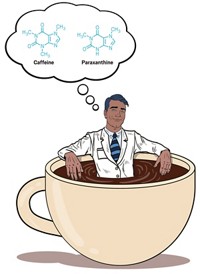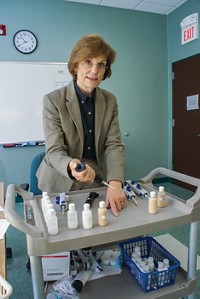Advertisement
Grab your lab coat. Let's get started
Welcome!
Welcome!
Create an account below to get 6 C&EN articles per month, receive newsletters and more - all free.
It seems this is your first time logging in online. Please enter the following information to continue.
As an ACS member you automatically get access to this site. All we need is few more details to create your reading experience.
Not you? Sign in with a different account.
Not you? Sign in with a different account.
ERROR 1
ERROR 1
ERROR 2
ERROR 2
ERROR 2
ERROR 2
ERROR 2
Password and Confirm password must match.
If you have an ACS member number, please enter it here so we can link this account to your membership. (optional)
ERROR 2
ACS values your privacy. By submitting your information, you are gaining access to C&EN and subscribing to our weekly newsletter. We use the information you provide to make your reading experience better, and we will never sell your data to third party members.
Environment
The Pleasure Principle
Flavor and fragrance work combines biology, psychology, and chemistry
by CORINNE A. MARASCO, C&EN WASHINGTON
June 7, 2004
| A version of this story appeared in
Volume 82, Issue 23
What does "clean" smell like to you? What do you think cool raspberry tastes like? Do you prefer a shampoo that's fruity or floral? What is a "green note"? (Hint: it has nothing to do with paper.)
Think about the products you select as you make your way through the supermarket or department store. Perhaps it's brand loyalty or advertising or even the packaging that persuades you to buy one product instead of another. But perhaps it's that fresh smell or delicious taste. What may not be immediately apparent is that a tempting smell or delicious taste is often the work of a chemist.
The perfumers and flavorists profiled in this story love their jobs because their work focuses entirely on identifying what gives pleasure to humans--pleasure centers in the brain that light up with delight when we taste or smell something enjoyable. These scientists take an idea or an inspiration and transform it into something tangible. And while they aren't credited publicly for their work, they take a great deal of satisfaction in seeing a product they've worked on displayed on store shelves.
Each project a perfumer works on involves creating a specific fragrance formula for a shampoo, a deodorant, a fine fragrance, a bar of soap, or some other product. Each formula contains many ingredients, both natural and manufactured. "I have had so many opportunities to see something launched that I've worked on," says Zerlina Dubois, a research fellow perfumer in the beauty care division of Procter & Gamble, Cincinnati. "Every day I probably work on 20 formulas, depending on the product. It's so exciting because I'm creating new scents that people will use." Dubois has a bachelor's degree in biochemistry--and studio art--and a master's in organic chemistry.
Stacy Hertenstein, who is also a perfumer at P&G, agrees. "It's always an interesting job because the consumer is the boss. We're constantly pushing the envelope to make something the consumers will love. There are so many competing products on the market that we have to come up with new ways to get their attention." Hertenstein holds a chemical engineering bachelor's degree.
Formulating may take several iterations--combining ingredients, smelling them in various media, testing the diffusion, and reviewing the formula--until the right formula is achieved. "We're always smelling materials, looking for new materials or how they look in a formula," Hertenstein says. "You might start with a fragrance that you want to be fruity and floral, and it may take 100 tries before you get the right combination."
Formulating is also highly collaborative work and can involve fragrance design managers who provide the concept, suppliers who provide the aroma compounds, flavorists who share ideas about materials, product developers, and even other perfumers. Also, feedback from consumer groups that critique new products must be incorporated since the product has to appeal to a wide range of consumers with different tastes.
Both Hertenstein and Dubois are always on the lookout for new fragrance trends, which can be found just about anywhere. Very often, they look to the fashion industry for clues since "fragrance is very tied to the fashion industry and fashion trends," Hertenstein says.
PERFUMERS LEARN the tools of their trade on the job. They must familiarize themselves with the thousands of aroma chemicals that are the palette for their work and how to combine them. "You need to understand the different chemicals you're using, their volatility, and how you can use their performance in your formula," Dubois says. "Consumers are so scent-involved, a chemistry background gives you an edge because you're looking for ways to make the chemicals do more. People want products that last longer and retain their scent longer while the company wants you to create a formula that does everything and costs less."
Continually satisfying customers is one challenge that formulators face. There are also projects that represent technical challenges, according to Hertenstein, such as chemical stability. For example, if you have a clear product in clear packaging, color stability is a challenge. Creating a product that is unscented is another.
Fragrance chemistry is also found in other parts of the manufacturing chain. Elizabeth Piaggesi is R&D manager at FMI, a full-service contract manufacturer in Allentown, Pa., that specializes in short-run production for the fragrance, household products, and personal care industries. In her role, she oversees all new product development and quality control, so she sees a product go from conception to completion.
"As a contract manufacturer, we go the whole nine yards," she says. "We start with an idea, then produce, manufacture, and ship the product. It's a vertically integrated process right from ordering the raw materials to shipping the product."
Piaggesi creates products around fragrances. For example, one of FMI's clients is a household products company that makes a diverse line of aromatic cleaning products. Not only do the products feature different scents, they also represent the company owner's commitment to products that are biodegradable and phosphate free. In addition, the products must use vegetable-based surfactants and essential oils, and cannot use antibacterial ingredients or be tested on animals.
"Experience" products, such as aromatic cleaning products, have grown in popularity and give consumers a range of fragrance options--that is, when you clean your kitchen, it can smell like the beach, pink grapefruit, a lavender field in Provence, or a just-mowed lawn. Piaggesi says she spends a lot of time and effort working to achieve that natural smell as well as meeting this client's goals of biodegradable and environment-safe products.
"THE NUMBER ONE skill is listening," she says, "because the client articulates what the end product is. I have to give the customer what they want, so I need to pay attention and know what questions to ask." Being detail oriented is another requirement, she adds, because in a quality control role she needs to focus on procedures and standards.
Piaggesi attributes to her chemistry training her solid foundation in tackling the challenge of combining aromatics with cleaning agents. She has B.S. and M.S. degrees in chemistry from Lehigh University. "But a lot of my work is trial and error," she says. "I'm either two or three or as many as 20 formulations away from what the consumer is looking for. I work with the fragrance house if my client is making a detergent in multiple fragrances and it needs to be clear and color stable or a particular color, which may prove trickier. Getting to the final formula means achieving a fine balance between meeting your customer's expectations and what you can realistically do."
Like Dubois and Hertenstein, Piaggesi's work requires her to stay fresh and informed about what is new and what trends are coming. In addition to staying up on consumer trends, she attends trade shows and talks to a lot of people, such as suppliers who may tell her about a raw material that they think is a trend.
One such supplier is Firmenich, which supplies flavors and fragrances to clients as well as other fragrance houses. One of the top three companies--with Givaudan and International Flavors & Fragrances--and the only large flavor and fragrance company that is still privately owned, Firmenich is headquartered in Geneva. "Ingredients are the heart of our company," says Bob Fuller, director of applied technology in Firmenich's perfumery division in Princeton, N.J. Firmenich creates perfume, flavor, and aroma chemicals, which are then incorporated in brands of fine fragrance, personal and household products, foods, and beverages.
"Our expertise is in both the molecules we make and the fragrances that add value to these molecules," he says. "We're one step down from a pharmaceutical company--we do pretty hard-core organic chemistry here. We make small levels of materials for fine fragrance to bulk chemicals like Hedione, which has a diffusive jasmine note. It was first used in fine fragrance, but is now used throughout the industry."
Fuller's group is responsible for surface cleaners, fabric care, air care, and personal care products. They take fragrances and address potential base issues--for example, recommending adding a stabilizer or removing an ingredient that is unstable or discolors--or they perform measurements to help a perfumer create a top-performing fragrance. "One of our biggest challenges is that we're a company that is highly functional, but we're selling something that is highly creative," he says. "A fragrance can contain 50 to 100 components, so we need to provide technical information to our highly creative people, and we have to make that information useful to them."
Firmenich offers many different opportunities for a chemist. Synthetic chemists search for new, original chemicals that are olfactorily interesting, stable, and safe. Analytical chemists contribute to the discovery and analysis of new aroma chemicals. Physical chemists examine how a flavor interacts with food or how a fragrance is deposited and released from a surface. Polymer scientists focus on new delivery systems for a flavor or fragrance, which can improve the final fragrance performance in the product.
Fuller says that about half of the work is solicited and done in collaboration with their clients. For example, a client may be changing its formula and wants to make sure that new fragrances will still perform. The other half, he says, is proactive. "Our researchers work on a particular technology, patent it, and then strategically market it to our clients."
The perfume business is small. Because the training is long and extensive, people who enter the perfume business tend to stay in it, so everyone gets to know each other, Piaggesi observes. But confidentiality is critical: In an industry such as personal care, where there are competing product lines, differentiation is what sets one product apart from another. "If you're working on a product that will be launched in two years, you cannot have any information leaks. We put strong safeguards in place to ensure our clients' confidence," Fuller says.
If your creative side indulges in food rather than scents, then a career as a flavorist is surely worth investigating. Flavor is a combination of taste and smell because taste is strongly linked, via the olfactory nerve, to our sense of smell. Studies suggest that as much as 90% of what is perceived as taste is actually smell.
"When you create something, it has to be incredible. You can't just have something that's pretty good."
CHEMISTS WHO work in the flavor industry research the development of new food products and the safety of cooking processes, develop new food products and processes as well as improve existing ones, conduct quality control to ensure legal and regulatory standards are met, and manage production processes.
P&G has a vigorous program for the study of flavor and how it relates to the performance of over-the-counter medications and oral care. There is a very active flavor industry between food and pharmaceuticals. On "Take Your Child to Work Day" at P&G, the flavor lab is one of the most popular spots, according to Bob Swaine, a research fellow in the Personal Health Care Flavor Technology & Development section. Swaine studies flavors, how they're formed, how they can be re-created, and how they perform in products. He has a B.S. in pharmacy from Northeastern University, in Boston, and an M.S. in food science and technology from Rutgers University. "We're creating experiences for the consumer that reinforce a given product's brand equity, product positioning, and product benefits," he says. "We also study the effect of other raw materials, processing conditions, environmental stresses, and packages on flavor performance."
Most flavors, Swaine says, are made up of a complex series of organic compounds--coffee has more than 800--so while a fundamental understanding of science is the cornerstone of a flavorist's career, what is essential is patience. "It can be a frustrating way to work," he says. "You need a good nose, sense of smell, taste, and a good aroma memory. One of my early mentors said that anyone with a good sense of smell can be trained--it's the ability to retain the memory that's important.
Advertisement
"If you think of flavors as merging two senses, aroma and taste," he adds, "aroma can be a powerful tool to a marketing company. How the consumer perceives the aroma can have a huge effect on how the consumer perceives the product." Perfumers and flavorists have a very specific vocabulary to communicate how something smells or tastes. For example, the crisp smell of a green apple or the light and fresh smell of parsley come from the green notes that affect how flavor is perceived.
Basic flavor research has its share of challenges, Swaine says. Flavors are not only composed of many chemical compounds, they are also present in trace concentrations, which can make the isolation and identification process tedious. For example, there is a compound found in grapefruit with a threshold of 2 x 10–5 parts per billion. In addition, the presence of specific compounds can influence other compounds as a synergist or an antagonist.
Satisfying the consumer is also challenging because the consumer can't always articulate smell and taste very well. "Every consumer is a critic and an expert," he says. "The consumer has a standard of excellence, and our challenge is to create a high-fidelity product--and it has to be distinctive. If it's not, you're just one of many." All challenges aside, he adds, where else can you get paid to smell and taste?
Where else, indeed? Derek Spors develops and produces new flavors for Ben & Jerry's Ice Cream in South Burlington, Vt., where playing with food is definitely part of the job description. He has a B.S. degree in food science.
Spors and his fellow "flavor gurus" look for inspiration by eating as many desserts as they possibly can to help develop new flavors. "There's never a shortage of great ideas," he says. "We start with an experimental batch and keep refining it. We normally start with a flavor on its own to make sure it tastes good by itself; then we gradually add flavor combinations. We're constantly tasting, critiquing, and evaluating."
New flavors go through sensory evaluation, by trained people or the general public, to determine which ones people prefer compared with current flavors. Another type of testing is called "difference testing"; if a fudge supplier wants to use a different cocoa, for example, a sensory panel would help determine if the end product will be affected by the change.
Of the hundreds of experimental flavors produced each year, only a small number ever make it to your grocer's freezer. The number of new flavors introduced by Ben & Jerry's each year varies, according to Spors, and depends on the number of flavors that are retired or needed to fill a gap in the product line.
Spors and his colleagues also create flavors to support causes that Ben & Jerry's has chosen to promote. For example, on the day that former Vermont governor Howard Dean entered the 2004 presidential race, the company created the Maple Powered Howard sundae as a tribute.
The biggest challenge, Spors says, "is that when you create something, it has to be incredible. You can't just have something that's pretty good; so if it's a pint of Ben & Jerry's, we give consumers the benefit of the value for the price. Indulgent and great can be difficult to deliver. I could create a great flavor, but if it costs $15 a pint, no one will buy it."
Spors says that the most important qualification for his job is "to pay attention and love your food. The more detailed attention you can give, the more you know about it, and the more you know about how things are flavored, the better, because there's an art to it. You have to pick up on those little details and nuances."
MORE ON THIS STORY
FROM WHERE TO HERE?
Profiled Professionals' Career Paths And Overall Job Outlook
FIRST COURSE
Basic Training For Food Scientists







Join the conversation
Contact the reporter
Submit a Letter to the Editor for publication
Engage with us on Twitter